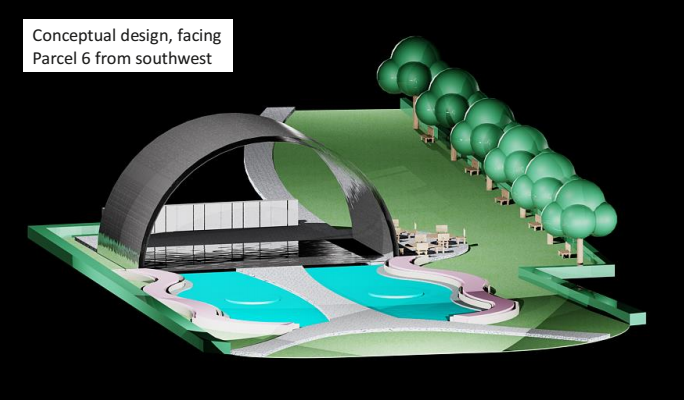
Exactly 96 years ago Thursday, a 15-foot high wave of molasses thundered down the streets of the North End moving at 35 miles per hour. The Great Molasses Flood is one of Boston’s more peculiar historical tidbits, etched in local folklore for its sheer craziness and lethality. A reported 21 people died and another 150 sustained injuries when the five-story holding tank on Commercial Street exploded. One North End resident now wants to memorialize all the victims, and the event itself, with a piece of public art.
Back in October, Bryan Webb, a civil engineer at Kleinfelder in Cambridge, began soliciting his design concepts for how MassDOT could cover certain I-93 ramp parcels on the Rose Kennedy Greenway. He proposed a commemorative 90-feet-long by 50-feet-wide arch under which would be two small pools with fountains.
The north side of the arch would boast a stone wall bearing historical accounts, images and the names of those who lost their lives in the notorious incident, and a walkway would lead people through the back of the arch to a public green space complete with park furniture and plenty of flora.
According to the Boston Art Commission, there’s a single plaque located at the entrance to Puopolo Field, placed by the Bostonian Society, in remembrance of the disaster.

Webb conceived the idea for his arch when considering ways to get involved in the community. Being a civil engineer, he thought it most prudent to use the skills already loaded in his arsenal.
“It’s not often you get to create a park and green space in an urban environment,” Webb told BostInno. “I thought, ‘How can we take the time to make this open park plan our own, and tie it into local history?'”
Webb humbly credits MassDOT and the Boston Redevelopment Authority for catalyzing the thought process and involving the community. It was them, after all, who decided to crowdsource ideas for how best to cover the ramp parcels.
Last Thursday, Jan. 8, MassDOT released refined alternative concepts for how best to re-imagine the ramp parcels. Based on the prior community meeting held in October, the revamped concepts reflect logistical concerns, such as existing highway signs, lights and infrastructure. For this reason, the designs are mostly of pathways surrounded by both low and dense planting, accompanied by hedges, fencing or public art to further screen the ramps from potential passersby.
Unfortunately, Webb’s pitch didn’t make the cut. He’s hardly discouraged, though. Award-winning writer Stephen Puleo, author of “Dark Tide: The Great Boston Molasses Flood of 1919,” was so taken by Webb’s project that he’s been trying to connect Webb with the appropriate personnel to hopefully get it some legs.
Whether it takes shape or not, the project is not the endgame for Webb. More than anything, he wants what the community at large wants. And if they prefer something over his idea, he’s perfectly content with it.
“I’m just a resident living in the North End and trying to get involved,” Webb said. “Community involvement is most important to me.”
The Greenway ramp parcel designs are now open for public comment, so be sure to voice your opinion on the matter from now until February 11. A team is expected to convene in March or April to take local thoughts and opinions into account and refine the concepts further. A follow up meeting will be scheduled shortly thereafter.

